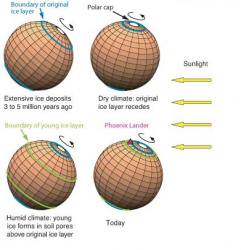The polar ice caps on Mars have been there for a long time; although, they haven’t always stayed the same size, or shape. They cover the surface between the poles and approximately 60° latitude today, but Norbert Schorghofer of the Institute for Astronomy and NASA Astrobiology Institute in Hawaii has shown that Mars has had at least forty major ice ages during the past five million years.
The Martian ice caps are divided into three layers: a massive bottom sheet, a porous middle layer and a thin, dry, dusty top layer. The makeup and extent of the ice coverage has varied over its long history due to both precipitation of water vapor from the atmosphere, and the diffusion and condensation of water from pores in the ice.
“Although neither of the two mechanisms by itself could simultaneously account for the mass fraction and latitudinal boundary of the observed ice, their combination provides just enough ice at the right places,” Schorghofer said.
Unlike the Earth, Mars doesn’t have a Moon to keep its tilt in check. Instead, the planet is able to tilt as much as 10-degrees from its current angle. This can create tremendous variation in the size of its ice sheets.
Earlier studies of the ice showed that the shifting of the ice was due largely to Mars’ varying tilt (obliquity), and thus changes in global and local temperatures affecting the humidity levels of the entire planet. Schorghofer used computer modeling that takes into account thermal and atmospheric conditions, as well as the growth and retreat of the ice sheets. His research shows that the transfer of water vapor from the ice into the atmosphere, and the condensation of this water back into the ice profoundly altered the way in which the ice caps melted and re-froze.
Closer to the poles, the amount of ice changes very little over time. But near the edges of the sheets, the volume of ice has varied by as much as 100,000 cubic km during each ice age. Mars’ icy love handles have each also shrunk an overall depth of 60cm over the past 2.5 million years.
Understanding the cause for ice ages on Mars may help us learn more about the climate history of other planets, including Earth.
“The dynamic nature of the ice sheets makes Mars an ideal system in which to test and expand our knowledge of astronomical climate forcing. A great deal could be learned about terrestrial ice ages from the study of Martian ice stratigraphy – a longer, cleaner and simpler record than Earth’s,” Schorghofer said.
When the Phoenix Mars Lander arrives at the Red Planet in 2008, it might just see the different kinds of ice layers that Schorghofer is predicting.
Original Source: IfA

